“Beware the beast Man, for he is the Devil’s pawn. Alone among God’s primates, he kills for sport, or lust, or greed. Yea, he will murder his brother to possess his brother’s land. Let him not breed in great numbers, for he will make a desert of his home and yours. Shun him; drive him back into his jungle lair, for he is the harbinger of death.” – Sacred Scrolls 29:6
Although there are many other great lines in the film, this is among the most chilling and polarizing in the original Planet of the Apes which was released 50 years ago this year. Featuring a cast that includes Charleton Heston (The Omega Man 1971, Soylent Green 1973), Roddy McDowell ( The Legend of Hellhouse 1973, Fright Night 1985), Kim Hunter (A Streetcar Named Desire 1951, Beneath the Planet of the Apes 1970), Maurice Evans (Rosemary’s Baby 1968, Beneath the Planet of the Apes 1970), and Linda Harrison (Beneath the Planet of the Apes 1970, Cocoon 1985), the Sci-Fi classic was written by Rod Serling (The Twilight Zone series, Night Gallery series) and Michael Wilson (5 Fingers 1952, Lawrence of Arabia 1962), produced by Arthur P. Jacobs (Beneath the Planet of the Apes 1970, Escape from the Planet of the Apes 1971) and directed by Franklin J. Schaffner (Patton 1970, The Boys From Brazil 1978).
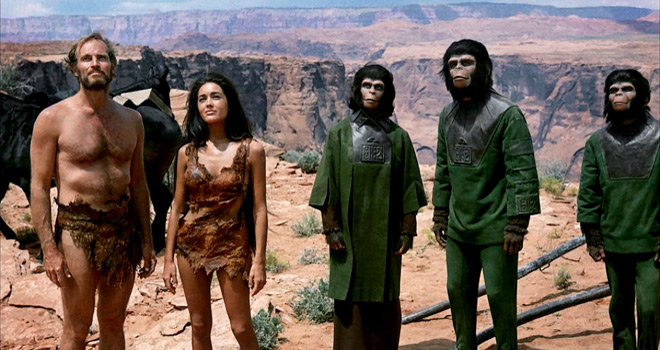
Having several screenings before its broad US theatrical release back on April 3rd in 1968, Planet of the Apes follows a trio of American astronauts (four if you count the ill-fated female, Stewart) as they journey at near the speed of light to a distant planet thought to be habitable. Taylor (Heston) is the last one to go into cryo-sleep and is recording on the ship’s log. As he records his thoughts to “whoever is listening,” a shot is shown of the ship’s time as 7-14-1972 and Earth’s time 3-24-2673. He goes to sleep and is abruptly awoken as the ship crash lands on a mysterious planet. Before He, Dodge, and Landon abandon ship, Taylor notes that Earth time is now 11-25-3978. They make their inland and find a race of mute humans that are not much more than savages. All of a sudden, a horrid primal yell lets loose over the masses, as the humans and the astronauts are corralled and/or hunted by gorillas on horseback. Taylor is captured and taken to a city, where he discovers this planet is inhabited by a society of evolved cultured Apes.
With an estimated budget of $5,800,000, Planet of the Apes was shot at multiple locations. Some of the film was shot on the 20th Century Fox Studio stages 20-22, but the majority was shot in exterior locations. The crashed rocket ship scene was shot at Lake Powell, UT. Zuma Beach and Westward Beach, Malibu were used for the journey to and including the Statue of Liberty scene. Ape City was set up in Malibu Creek State Park. The journey over the mountains at the beginning and towards the end was shot in various locations around Arizona.
“It’s a madhouse…A MAAADHOOOUSE!!!“A large part of that budget, different personal accounts fluctuating between $500,000 to $1,000,000, went towards the pioneering Special FX of John Chambers, which was based on a technique he had used during World War II to give disfigured veterans a normal appearance. Chambers spent many hours watching the apes at Los Angeles Zoo, studying their facial expressions. The special FX proved to be one of the biggest stumbling blocks preventing 20th Century Fox from committing to the project was its fear over how the ape faces would appear on screen.
Eventually, they coughed up 5,000 dollars for a test scene to be shot with Charlton Heston playing alongside the made-up Edward G. Robinson (Little Caesar 1931, Key Largo 1948) as Dr. Zaius, and James Brolin (The Car 1977, The Amityville Horror 1979) as a character called Mr. Cornelius. The studio was very excited about the results of this test but still delayed green-lighting the film for a further six months. It was only after 1966’s Fantastic Voyage became a hit and showed the viability of Science Fiction as a genre that Planet of the Apes was given the go-ahead, but without Robinson, as he suffered from a weak heart and did not think he could endure the day-to-day rigors of performing in the ape make-up. The make-up team consisted of over 80 make-up artists. When adjusted for inflation, the movie holds the world record for the highest makeup budget (then $345,542), which represented about seventeen percent of the total budget ($2,000,000).
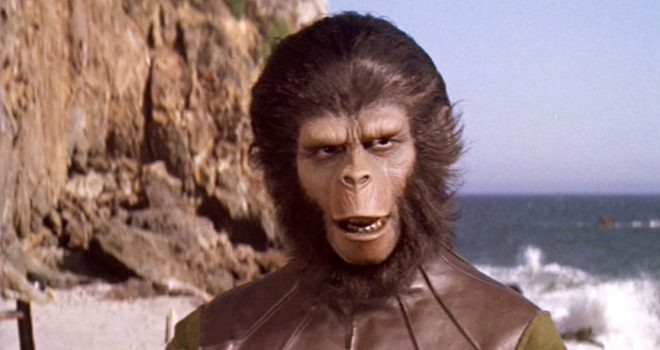
Makeup FX alone does not make up a film, though; it takes strong actors who need to be able to act through the makeup. Not only did Roddy McDowall turn in a great performance as the charismatic, yet conflicted Cornelius, he recommended to his co-stars in makeup that they should frequently add tics, blinks, and assorted facial gestures to add a sense of realism and keep the makeup from appearing “mask-like.”
Leading the cast, Charlton Heston’s Taylor was a no-nonsense tough guy who knew a little about everything. Even though he came off as slightly over-dramatic at times, he still delivered a believable role. However, he was not the studio’s first choice. Sean Connery (Goldfinger 1964, The Rock 1996), Steve McQueen (The Great Escape 1963, Bullitt 1968) Paul Newman (The Hustler 1961, Cool Hand Luke 1967), and even John Wayne (McLintock! 1963, The Sons of Katie Elder 1965) were considered for the role of Taylor. On top of that, he was sick during much of the film with the flu. Rather than wait for him to get better, the producers felt that his hoarse voice added something to the character of Taylor. According to Heston’s diary, after filming the scene where Taylor and Nova are forcibly separated, he wrote that he was feeling like hell while shooting because of his illness, and felt even worse “every time that damn fire hose hit me.”
“Zira,” played by Kim Hunter, one of two females in the film, was a sweet human sympathizing scientist who wanted nothing more than their society to evolve and to gain a profound understanding of humans. She was very strong-willed, and would not be silenced, even when Cornelius pleaded with her to be so. This is most evident in the courtroom scene where Zira is stating facts to the three orangutans including Dr Zaius, where objections are being made against her every word, and sustained. She finally says with the utmost conviction, “Sustain ALL objections, but listen to reason.” Turning down the part of Zira was one of Ingrid Bergman’s greatest regrets. Much surprised at how well the finished film turned out, she later confided to her daughter Isabella Rossellini that in hindsight the film would have been an ideal opportunity for her to “disregard her regal bearing.” She also regretted missing the opportunity to work with Charlton Heston.
Finally, there was Maurice Evans who played “Dr. Zaius:” Chief Defender of the Faith and Minister of Science. Dr. Zaius was a wonderful contradiction unto himself as religious faith and science do not mix. This in turn made him quite flawed. Imagine simultaneously knowing the truth about the human race existing before the current society of apes, and having to perpetuate the lie that Apes were and always will be the dominant species. Maurice Evan’s performance was nothing short of stellar. His voice alone commanded attention in every scene. Yul Brynner (The King and I 1956, Westworld 1973), José Ferrer (Moulin Rouge 1952, Dune 1984), Alec Guinness (The Bridge Over the River Kwai 1957, Star Wars Episode IV: A New Hope 1977), Laurence Olivier (Spartacus 1960, Clash of the Titans 1981), and Orson Welles (Citizen Kane 1941, Touch of Evil 1958) were considered for Dr Zaius.
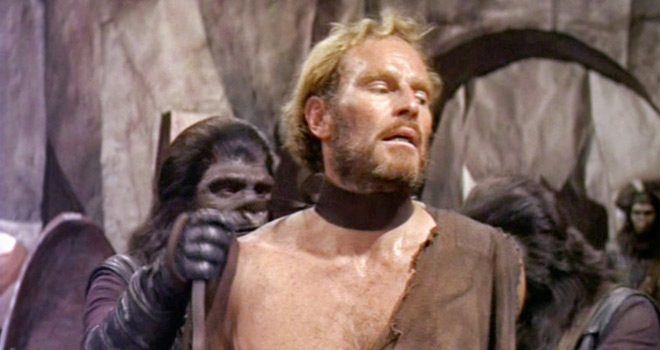
“Tell me: why are all apes created equal?” “Some apes are more equal than others, it seems.” Like in every society, there exists a class system. In Ape society, Orangutans are the elite “1%.” Chimpanzees are the middle class and more science-minded, and Gorillas are the lower, militaristic, class. Orangutans tended to control everything from faith to, presumably, even currency, though the currency is never discussed, but it is a reasonable assumption. The Chimpanzees are pacifists and more sympathetic to humans, but no less fearful of them. Finally, the Gorillas are the workers and will turn to violence first. The Apes, though obviously a different species than man, were indeed no better; The top class lied to the lower classes so as to keep up the status quo. Turns out that no matter the species, they fall into the same pitfalls as every society, no matter how learned they may be.
“I can’t help thinking somewhere in the universe there has to be something better than man…has to be.“ Planet of the Apes was made and released during a very tumultuous time in American history: The Vietnam War, assassinations of leaders like John F. Kennedy and Martin Luther King Jr., and other atrocities. Taylor’s character fled Earth due to being so disassociated from the human race. It is, therefore, a punch in the gut when he discovers he landed in the very place he was trying to escape from, and that Man was responsible for the current state of the planet, hence the destroyed Statue of Liberty. Taylor escaped the humans and the planet he loathed only to find himself back where it all started. “You got what you wanted, Tiger. How does it taste?”
Although Planet of the Apes in some regards is now considered dated, it remains a groundbreaking compelling Science Fiction story with great special FX that laid the groundwork for modern prosthetic special FX. It was so impactful, that it spawned four sequels, two television series, a mountain of merchandise, a remake in 2001, and a new re-imagined trilogy which has done exceptionally well in recent years. The original Planet of the Apes is a cinematic classic that, even after 50 years, can still entertain and stimulate the minds of modern audiences.
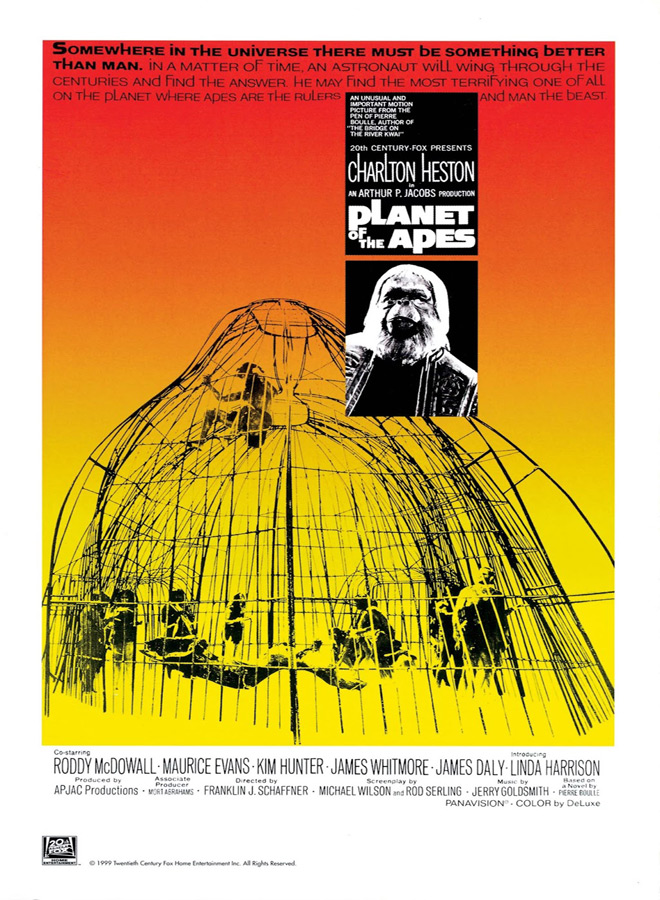

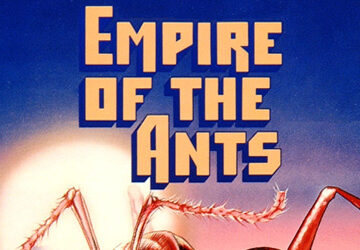



No comment